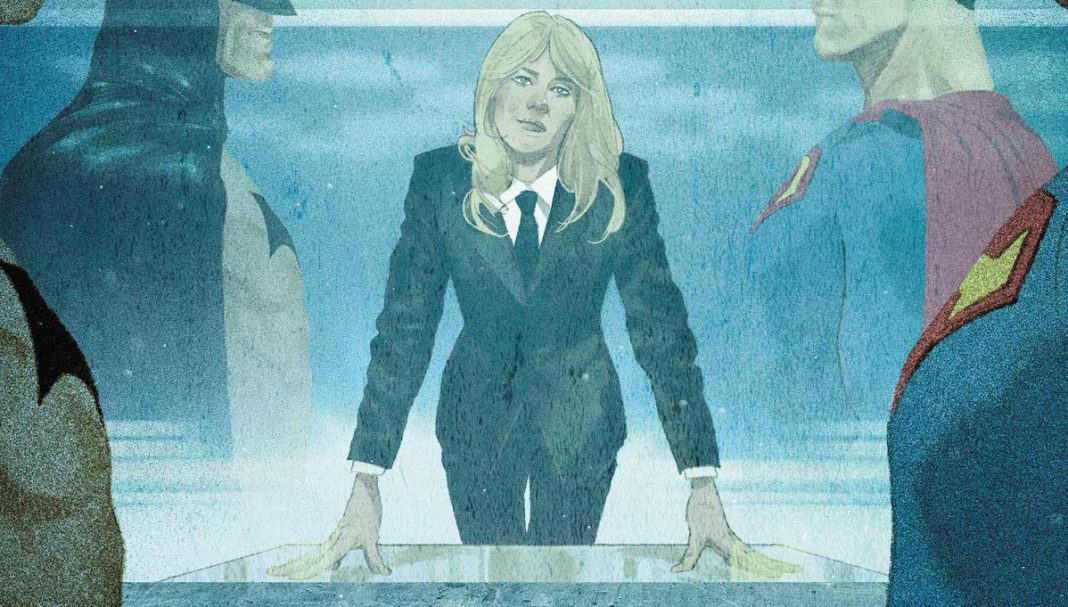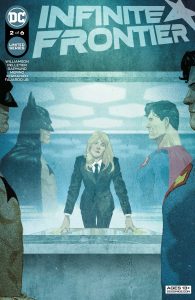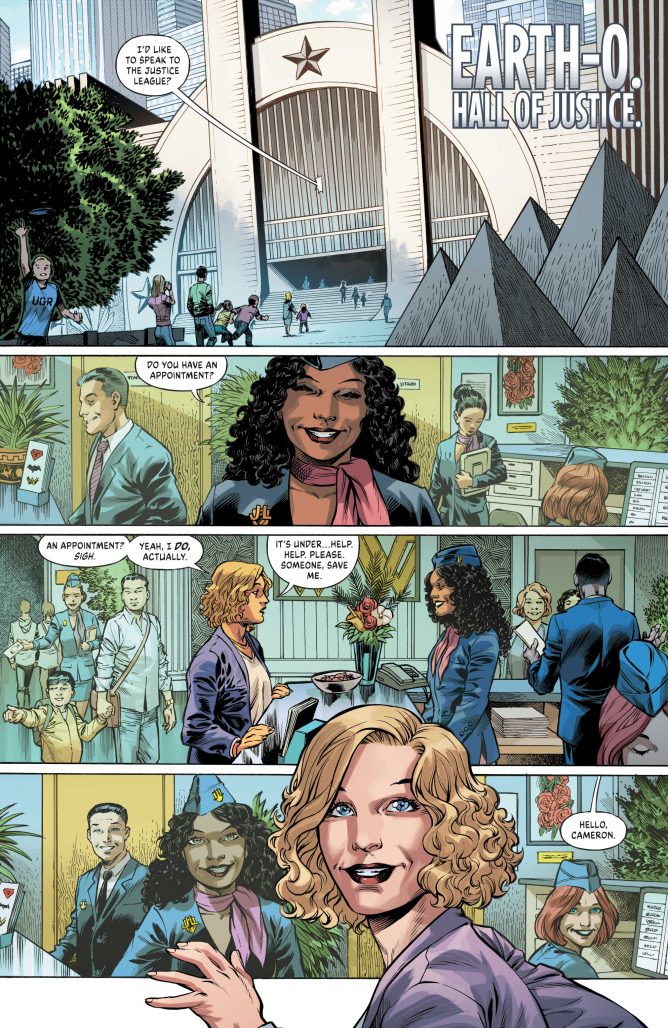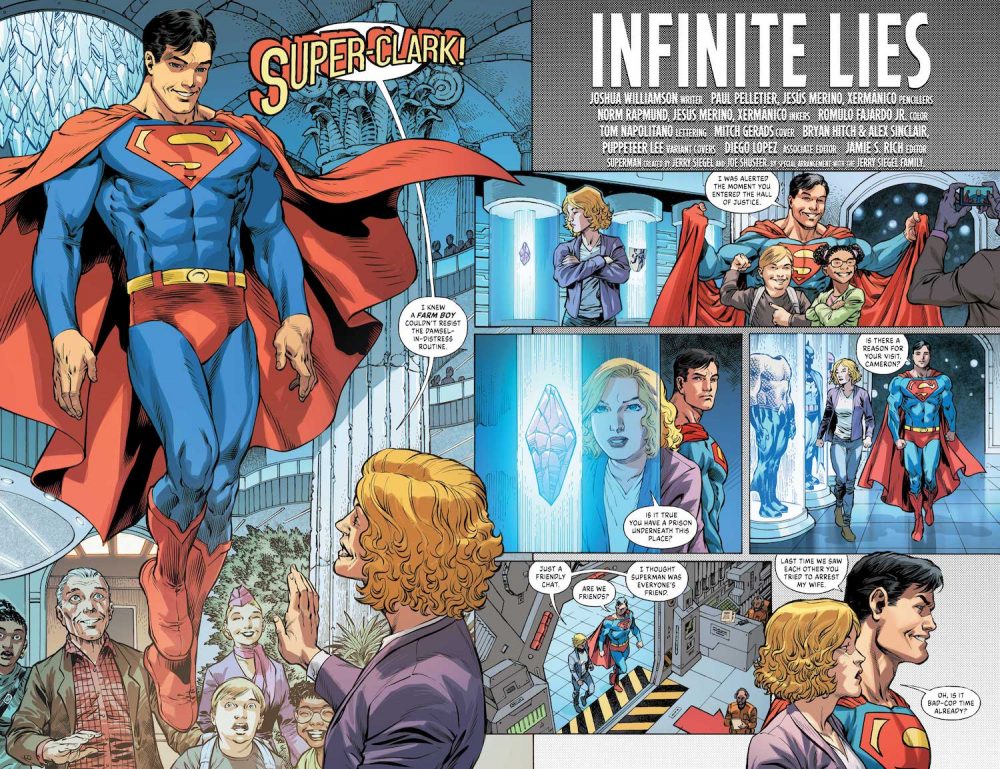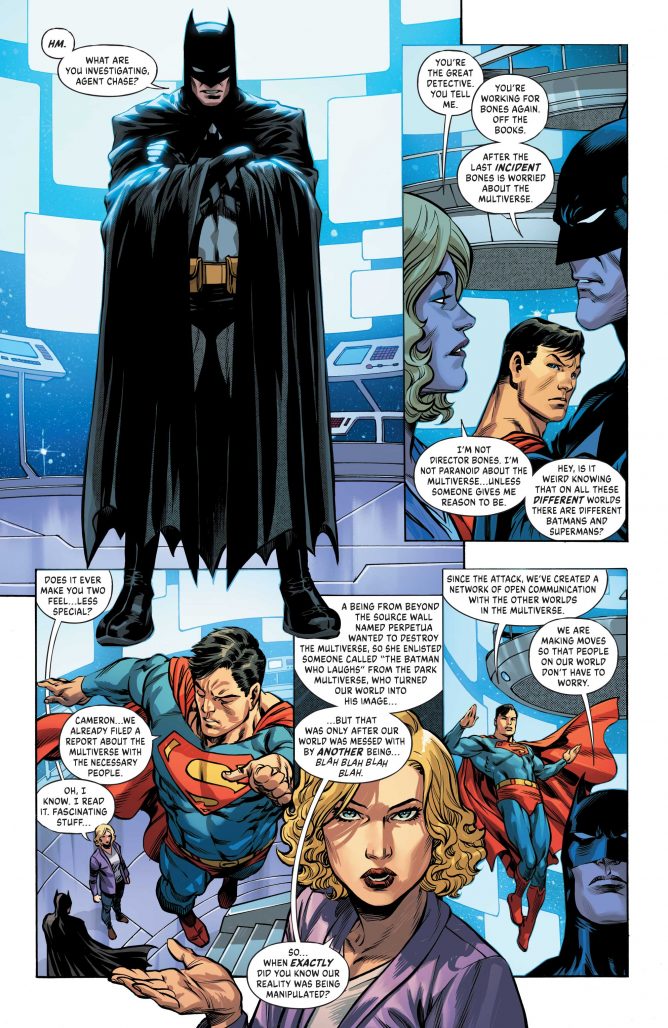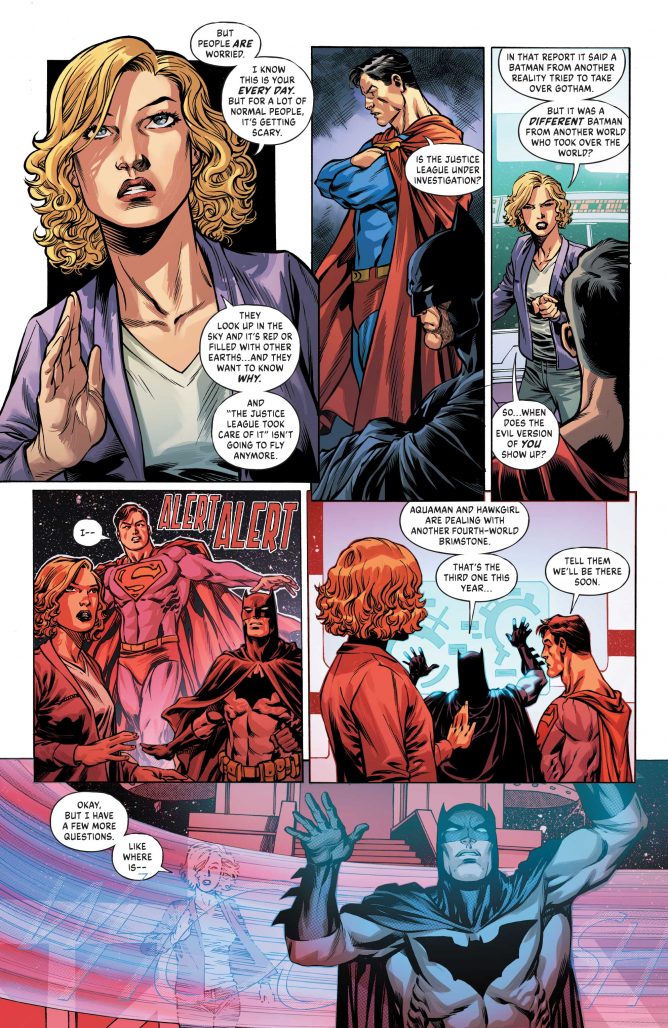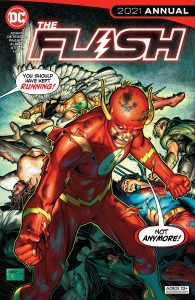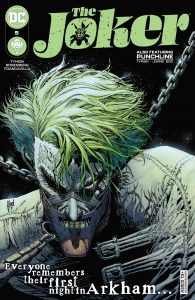THIS WEEK: Infinite Frontier #2 takes readers through a DC Universe event from the perspective of the publisher’s less-seen characters as a new conspiracy takes hold. Plus, in The Flash Annual 2021, Wally West and crew work to undo a recent story that rankled many folks.
Note: the review below contains spoilers. If you want a quick, spoiler-free buy/pass recommendation on the comics in question, check out the bottom of the article for our final verdict.
 Infinite Frontier #2
Infinite Frontier #2
Writer: Joshua Williamson
Artists: Paul Pelletier, Jesus Merino, and Xermanico
Inkers: Norm Rapmund, Jesus Merino, and Xermanico
Colorist: Romulo Fajardo, Jr.
Letterer: Tom Napolitano
Infinite Frontier #2 is essentially the second part of DC Comics’ big summer event, or, if not a proper event (there aren’t any crossovers aside from some spinoff vignettes), at least the major linewide overarching story of the day. And this issue begins from the perspective of Cameron Chase, who isn’t far off in space spying on Darkseid or lurking at the center of the multiverse, bantering with one of the Monitors. No, when this book opens, Chase is standing at a reception desk in the Hall of Justice, requesting to speak with someone from the Justice League.
This opening is a great encapsulation of what Infinite Frontier #2 wants this story to accomplish. It wants to be about major events in the DCU…just as seen through the perspectives of some of this world’s deep bench of characters (to be fair, I’m cheating here, because writer Joshua Williamson actually told me that’s part of the goal of this book). We next quickly see Superman and soon thereafter Batman, but, again, Chase is at the center of the proceedings, as depicted on this issue’s cover.
This to me is a refreshing way to experience a new DC Comics mega story, reminding me a bit of the beloved weekly classic, 52 (a key difference being that the DC Trinity was actually gone during that one). The nature of superhero comics is such that Big 2 publishers cycle through relatively similar stories, through crises and secret/civil wars/invasions, through the same multiverse shattering ideas, essentially. What this story is bent on doing is creating newness by focusing on characters outside the usual. It’s a great choice, really, and it definitely drives this second issue, which I should note (in case it’s not already clear) I liked a great deal.
All that said, I wouldn’t describe this story as small or grounded, in spite of its compartmentalizing the big names in the DCU. After the opening wherein Chase sort of interrogates Superman and Batman about the transparency with which the League approaches giant happenings like the recently-concluded Dark Nights: Death Metal, we next cut to a nine-panel grid of earths throughout the multiverse. It’s on this page (as well as those that follow) that the full nature of this story is apparent: Infinite Frontier, my friends, is a conspiratorial mystery that spreads throughout multiple earths.
That’s really what’s for sale in Infinite Frontier #2: a multiversal conspiracy as seen through the perpsectives’ of characters like Chase and President Superman. If — like me — that sounds appealing to you, I’m confident in predicting you’ll like this comic (and, indeed, this entire series). It’s also loaded with fresh uses of well-tread and recent characters (some of whom — specifically thinking of Flashpoint Batman — I don’t think I’ve ever previously enjoyed, not really). This is a book that both wants to do new things with characters while also just giving long-time readers a chance to see old favorites on a big stage, being relevant again. I mean, we get a scene here that stars Alan Scott, Obsidian, Mister Terrific, and Vandal Savage: DC nerds, rejoice.
It’s all looks great too. Xermanico has been a fantastic choice for a main series artist, and that continues to be the case in Infinite Frontier #2, wherein support is lent by Paul Pelletier (inked by Norm Rapmund) and Jesus Merino, both of whom contribute ably.
Finally, Infinite Frontier #2 ends on an absolutely madcap story note, just as the first issue of the series did. We get a bit more of Roy Harper as a Black Lantern, followed by Chase sneaking on a military base to confront Captain Atom, whom she has learned is not really Captain Atom from Earth-0, blown up as he was during Dark Nights Death Metal. He’s actually an imposter who we learn has been sent by the Big Bad of this story, Darkseid. As the book ends, Captain Atom does what Captain Atom often does, and, once again, explodes. It’s a great last page (one thing I like in comics is ending on a big explosion, as opposed to starting with one, which seems to happen a lot these days for some reason), one that left me thinking perhaps the biggest strength of this story is haze.
See, we’re basically still in the aftermath of Dark Nights Death Metal, which was maybe a little too BIG. We know the day in that story was saved by the heroes and the world put back together, but we also know some pieces were left unaddressed. That’s a tremendous gift to creators dabbling in the multiverse, enabling them to gaud the audience into guessing which characters are familiar Earth 0 versions, and which might be Darkseid-controlled imposters from somewhere else. And friends? I’m very much into that, which makes my verdict for this issue an easy one…
Verdict: Buy
Round-Up
In The Flash Annual 2021, Wally West emerges from the speed force during the pivotal moment of Heroes in Crisis, a story in which power erupts from his body and kills patients at a superhero trauma clinic who followed him outside due to concern. It’s a story I didn’t enjoy (and one that writer Tom King himself once bemoaned at a convention as a book nobody liked), feeling as I did it was at odds with the sci-fi wackiness inherent to The Flash. Well, this issue is absolutely brimming with said sci-fi wackiness, and I loved it. I got a kick out of Wally communicating with fellow Flash Barry Allen, Green Arrow, and Mister Terrific, as they try to essentially undo Heroes in Crisis. It’s almost like they an editorial conversation translated to the page. At one point, Barry says “This is hard to say…but all of this happened.” And then, “There’s nothing we can do.” They do, however, turn it all into a pretty entertaining Flash story that leaves Wally West as a motivated hero with his family intact, speeding off toward the future of the title, whatever that will entail. The story here is told by writer Jeremy Adams, artists Fernando Pasarin and Brandon Peterson, colored by Hi-Fi and Michael Atiyeh, and lettered by Steve Wands.
- I’m the resident WildStorm fan in the DC Comics crew here, and as such, I got a huge kick out of the last story in Batman: Urban Legends #5, wherein Grifter (who has been sort of kicking around lately as a Batman side character doing guard work for Lucius Fox) reunites with a set of familiar WildStorm characters, characters I must admit I was convinced we’d probably seen the last of in new stories (although with the characters’ creator as a company exec, that was obviously foolish). The end tag of the book promises the WildC.A.T.S. will return, which hell yeah, great. Writer Matthew Rosenberg in particular has done a great job with Grifter. His story here is illustrated by Ryan Benjamin, colored by Antonio Fabela, and lettered by Saida Temofonte.
- I continue to think Future State Gotham is an under-discussed book. DC Comics has been rightly criticized in recent years for being a little meat and potatoes (so to speak) with its monthly comics choices, sticking to predictable sets of characters and story concepts, especially during the DC Rebirth era. And while, yes, this is a Bat-family title, it’s one set in an alternate future that may or may not eventually happen. Oh, and it’s done in the style of manga. I’m enjoying it quite a bit, and I’m all for more DC Comics oddities like this one moving forward. This book is co-written by Williamson and Dennis Culver, with artwork by Giannis Milonogiannis, and letters by Troy Peteri.
Finally, The Joker? Still great. It feels like there’s no room in the main title for two Batman mainstays — Jim Gordon and The Joker — but this book gives us a complex exploration of the dynamic and history between them. It’s really immersive, and currently my favorite Bat-family title (main book aside). That’s saying a lot, because the competition is fierce, with this one just edging out Nightwing. This issue was written by Matthew Rosenberg with James Tynion, illustrated by Francesco Francavilla, and lettered by Tom Napolitano, with a back-up story written by Sam Johns and Tynion, illustrated by Sweeney Boo, and lettered by Ariana Maher.
Miss any of our earlier reviews? Check out our full archive!


